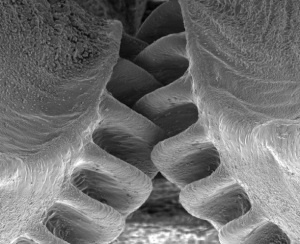Well, kind of…
This week, scientists at the University of Cambridge have released their discovery of naturally occurring mechanical gears in a living organism. That’s right, as awesome as bikes and trains are, nature beat us to the punch. This observation was made in the juvenile Issus coleoptratus, a small, jumping insect found very commonly in gardens throughout Europe, and represents the first discovery of mechanical gearing in a living organism.
Just looking at the Issus, it doesn’t look like much, and it’s easy to wonder why no one thought much of it in the past. But this news marks the discovery of a truly incredible feat of evolution. The aforementioned mechanical gear structure is found in the hind legs of the Issus, and is used to bring the movement of the legs during a leap into perfect synchronicity. The reason for this mechanical synchronicity is that the nervous system alone does not actually possess the precision to move both legs at the exact same time and rate, and a difference in motion of even a few microseconds can cause the Issus to fly out of control. This almost seems shocking given the established power that the nervous system has in living organisms, but it is equally amazing to think of the speed of movement that is required to exceed the brains ability to send synchronized nerve impulses to both legs.
What is also interesting is that these structures appear only in juvenile stage of the insect, perhaps due to the fact that the nervous system is still developing to a point where absolute synchronicity of movement is possible without mechanical assistance. At this point, scientists are unsure about connections between the juvenile and adult stages and the potential role of the structures later in life. No matter what though, this discovery highlights the incredible power of evolution on Earth, and the feats that is capable of. As the co-author Gregory Sutton states: “These gears are not designed; they are evolved…”
Sources:
Burrows, Malcolm, and Gregory Sutton. “Mechanical Gears Seen for the First Time in Nature.” Mechanical Gears Seen for the First Time in Nature. Bristol University, 18 Sept. 2013. Web. 18 Sept. 2013.
Images:
http://jjsphotographicblog.blogspot.com/2012/08/hopping-mad-down-in-kent.html


